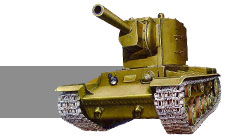


Translation
- 28 guests
- 7 robots
Visitors
| Today: | 567 |
| Yesterday: | 2320 |
| This Week: | 4878 |
| Last Week: | 15089 |
| This Month: | 4878 |
| Last Month: | 59208 |
| Total: | 128582 |
SMK Experimental Heavy Tank |
 |
 |
Created Tuesday, 20 September 2005 18:56
|
|||
Last Updated on Sunday, 11 October 2009 18:17
|
|||
|
In It was planned to use the transmission and drive train of the T-35 in the new tank. However, the Design Bureau KhPZ, which in normal circumstances lacked sufficient resources to carry out such complex work, had been subjected to mild repressions among its engineering staff working on the project. Therefore, despite countless demands of the GABTU, by the beginning of Lacking agreements for the preparation of these new vehicles, the plants carried out preliminary design work until August 1938. Full work began only after promulgation of Resolution #198 of the Defense Committee of the SNK of the USSR on The designs of the new heavy tanks were reviewed in a joint session of the Politburo of the TsK VKP (b) and Defense Committee on The first test runs of the SMK outside the production facility were conducted on These tests were conducted through the efforts of factory drivers, for which special permission was received from Moscow. The workers selected for the tests underwent special abbreviated training in driving the vehicles, firing the cannons and machine guns, and as well other skills required for combat. The commander of the SMK crew was Senior Lieutenant Petin, the deputy commander was Sergeant Mogilchenko, and the The SMK, T-100, and experimental KV tanks comprised a company of heavy tanks that was included in the 91st Tank Battalion of the 20th Heavy Tank Brigade. A Captain Kolotushkin was named commander of this company. The unit entered combat in the Khottinen area on December 17, 1939. The history of the combat employment of the SMK and T-100 tanks has been described in sufficient detail in many Russian and western publications. The general tenor of these descriptions is consistent almost everywhere and can be summarized as follows: «Moving at the head of a tank column, the SMK drove toward a pile of crates, under which were concealed high explosives. The detonation of these explosives damaged the idler wheel and track and the tank stopped. The T-100 and KV halted nearby, covering the damaged SMK. Taking advantage of this cover, the SMK crew worked for several hours to repair their tank. However, they were unsuccessful and had to abandon the SMK in the neutral zone.» From book to book what follows this description is a detective story about how brave Finnish scouts crept up to the tank and covertly removed the driver's hatch cover. This hatch cover, made from conventional (not hardened) steel because the constructors had not succeeded in sending it in for treatment, later fell into the hands of German engineers. These engineers decided that the SMK was made entirely from cast armor. And the decisions that followed from this conclusion played a large role in the Soviet victory over German fascist forces. However, examinations of archival documents indicate that all that is recorded above does not correspond to reality. The first time the heavy tank company went into combat was on On December 19, the SMK and the T-100 were assigned the mission to support our units that were penetrating into the depths of Finnish fortifications in the Khottinen area. Both vehicles moved forward, accompanied by five T-28 tanks. These tanks were already deep into the enemy's defenses when a powerful explosion occurred under the leading SMK. The T-100 and one T-28 halted near the damaged tank and the remaining four vehicles, seeking cover, moved forward. The SMK crew attempted to recover their tank by rejoining its damaged tracks, but they were unable to restart the engine. Countless attempts to tow the damaged SMK with the T-100 did not bring success. Because of the icy conditions, the tracks of the T-100 could not get traction and the T-100 could not move the SMK. The tanks had fought in the depth of Finnish positions for approximately five hours. Sergeant Mogilchenko was seriously wounded and the driver Ignatev was lightly wounded. Having expended all of their ammunition, the crew of the SMK moved over to the T-100. The overloaded T-100 (with The loss of the experimental tank was cause for some distress for the GABTU chief, The damaged SMK remained in the depth of Finnish positions until the end of February, 1940. Our forces caught sight of it on Regarding the history of the stolen hatch cover, this is just another myth. The hatch was made from hardened steel, as was the entire tank. Upon the liberation of the captured region the tank was inspected and the hatch was found to be present. Finnish scouts did not have to risk their lives to reach the SMK and clandestinely take something from it. The vehicle lay in the depth of Finnish positions and, if it had become necessary, they could have quietly disassembled the tank and hauled the pieces away. In fact, they did manage, with the assistance of captured Soviet tankers, to repair and tow away two T-28s, and for spare parts for these two intact vehicles to remove and haul away from many other tanks damaged in the same battle as the SMK not only optical instruments (sights), radios, and items of internal equipment but also turrets, engines, radiators, transmissions, and so on. Without doubt, as trophies the Finnish command was interested most of all in mass produced vehicles, which could be rebuilt and used, in lieu of some vehicle of an unknown type, standing alone some Translated by:
|
You need to login or register to post comments.
Add your comment. (total 0 comments)
© THE RUSSIAN BATTLEFIELD, 1998-2009



 KhPZ
KhPZ












